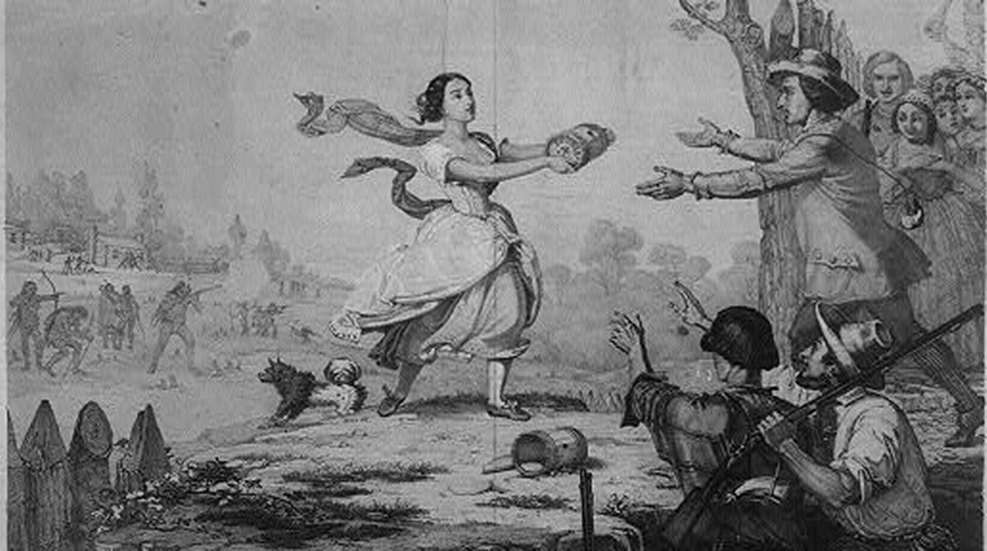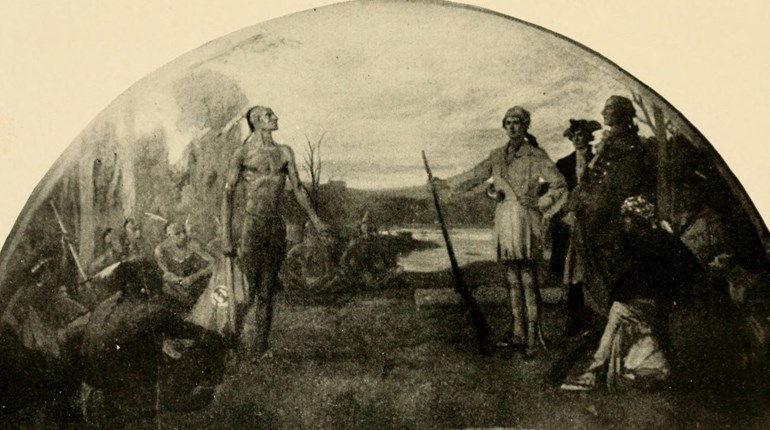
Along the upper Ohio River Valley in the late 1700s, there was no more famous family name than Zane—and for good reason. Ebenezer Zane, considered the first permanent white settler to the area, moved there with his wife Elizabeth and their young daughter in 1770. Together with just a handful of other hardy pioneer families, they quickly set to work building what one day would become Wheeling, West Virginia.
But settling the land would be a constant, deadly struggle for years into the future. Because the land was claimed by several hostile Native American tribes, the region had come to be known as “that dark and bloody river.” The tribes had already lost lands to the Europeans east of the Allegheny Mountains and were determined not to lose any more. To make matters worse, the American Revolutionary War was raging and the Indians were backing the British.
The first building the Zanes constructed was a crude log cabin—more of a fortified blockhouse, actually. They knew the threat of Indian attack was very real, and they wanted to be prepared. Once that structure was completed, they set about building Fort Henry. The fort itself was small as forts go, covering less than an acre in size. But it was enclosed with 8-foot-high pickets, logs that had been set on end in the ground and sharpened at the top—making it a much more defensible structure than even the Zane blockhouse.
All went well for the next several years until the early morning of September 1, 1777, when the fort was approached by nearly 400 Indian warriors: Wyandots, Ottawas, Chippewas and Mingoes. But what made the frontiersmen even more concerned was that the Indians were led by a British captain. Dressed in the traditional red coat with gold epaulets, white pants and black knee boots, he was accompanied by a man clad in buckskins who held high a muzzleloading rifle with a white rag of truce tied to the barrel. The pair boldly approached the fort to within just 30 yards, then abruptly stopped.
“Who are you?” Ebenezer Zane demanded from behind the walls.
“I am the representative of His Britannic Majesty, King George III,” said the captain in a loud voice. “In his name, I call upon you to surrender this fort and garrison. You have but 15 minutes to consider this proposition. I will wait for your answer.”
The answer wasn’t long in coming. A single rifle shot rang out from the fort, the bullet thudding into the ground near the two men’s feet. They quickly retreated, and the battle of Fort Henry was engaged.
Inside the fort were only 33 frontiersmen and a few women. In the nearby Zane blockhouse, about 60 yards away outside the fort, were four men and three women (including Elizabeth Zane) and seven children, four of whom were hers.
For six hours, the Indians poured hundreds of rifle rounds into the fort walls, shooting at every possible opening but doing little actual damage. Simultaneously, the frontiersmen—and the women who could handle a rifle—fired back, occasionally killing or wounding an Indian.
The men and women in the blockhouse held their own, but eventually their supply of gunpowder began to run critically low. They knew they would soon need more or be forced to face a tomahawk. The men were discussing among themselves who should try to make a run to the fort for more black powder when Betty popped up.
“I’ll go!” she said. “A man wouldn’t get 10 yards, but I don’t think they’ll shoot at me, seein’ I’m a woman.”
Silas Zane, Betty’s Zane’s brother-in-law, couldn’t argue her logic, but he was still hesitant. He knew that if Betty was injured or killed, his brother, Ebenezer, would never forgive him. Yet the situation was getting more desperate by the minute and he eventually agreed.
The heavy log that barred the door to the Zane blockhouse was lifted and the door cracked open just enough for Betty to slip through. Lifting her skirts so as not to trip over them, she took off for the fort, adrenaline pumping, running as fast as she had ever run in her life.
Seeing someone exiting the blockhouse, the Indians raised their rifles in anticipation; this would be an easy target. But upon seeing it was a woman, a shout quickly went up along the Indian lines, “Squaw! Squaw!” Amazingly, Betty covered the 60 yards to the fort without a single shot being fired at her.
The frontiersmen manning the fort gate saw her coming and opened it enough for her to squeeze through. There to meet her was her husband Ebenezer, but he was not happy. He scolded Betty for taking such a dangerous chance.
“There’s no time for that now, Eb,” she said, shrugging off his comment. “We need powder!”
Taken aback, Ebenezer Zane nodded to his men, and a small keg of gunpowder was soon produced. But it was too heavy for Betty to hoist to her shoulder, let alone run with. Holding out the bottom corners of the apron she was wearing to form a pouch, Betty ordered the men to pour in the gunpowder. When nearly two-thirds of the keg was emptied into her apron, she gathered it up in her arms, kissed her husband, and ordered the gate reopened.
If there was one thing the Indians admired, it was bravery. But when they saw this white woman running a second time, and obviously carrying something large in her apron, they no longer hesitated. The Indians opened fire.
Bullets whined past Betty Zane with a sickening sound, some kicking up dirt in front and behind her. few rounds even ripped through her skirts, but she remained untouched. Running in a zigzag pattern to make herself harder to hit, she soon arrived, panting, back at the blockhouse.
The badly needed gunpowder allowed those in the blockhouse to keep shooting, helping repulse the attack of Fort Henry. The fighting went on through much of the night, then gradually tapered off. By the next morning it had become eerily quiet. Had the Indians given up?
Colonel Zane sent out a few scouts from the fort to reconnoiter, and they soon reported back that it was true: The Indians were gone. Fort Henry and its inhabitants had survived, much to the credit of Betty Zane.
A classic tale of the American frontier, Betty Zane’s heroics are remembered and celebrated each year during Betty Zane Pioneer Days at Martins Ferry, Ohio, located just across the Ohio River from Wheeling. Today, there is also a small, nearby community in West Virginia named Betty Zane.





































